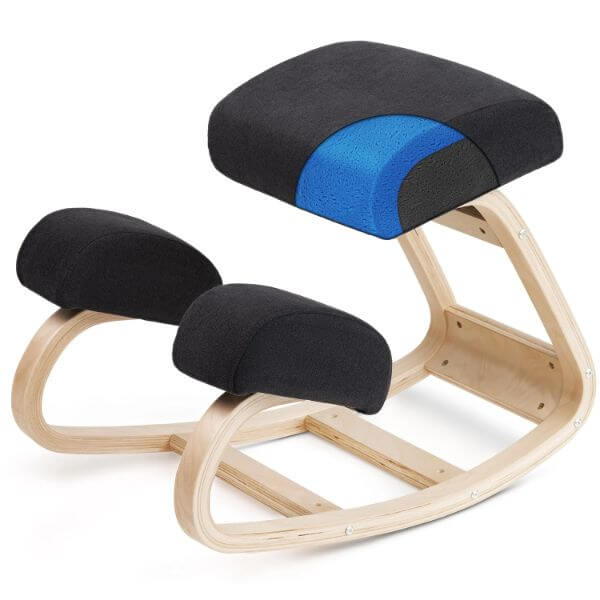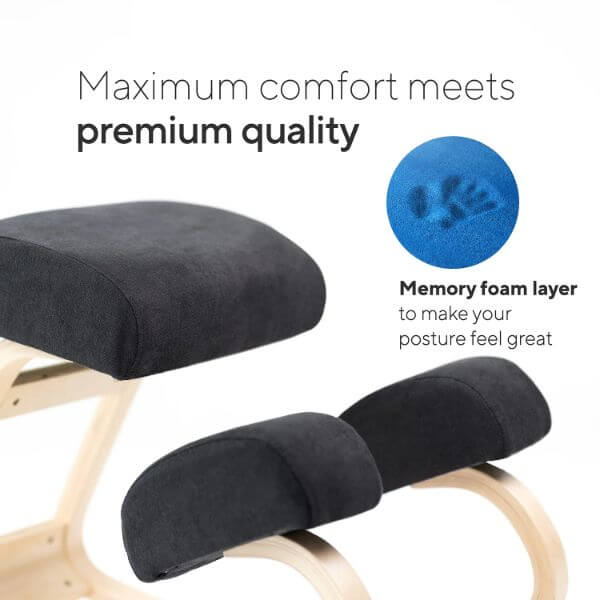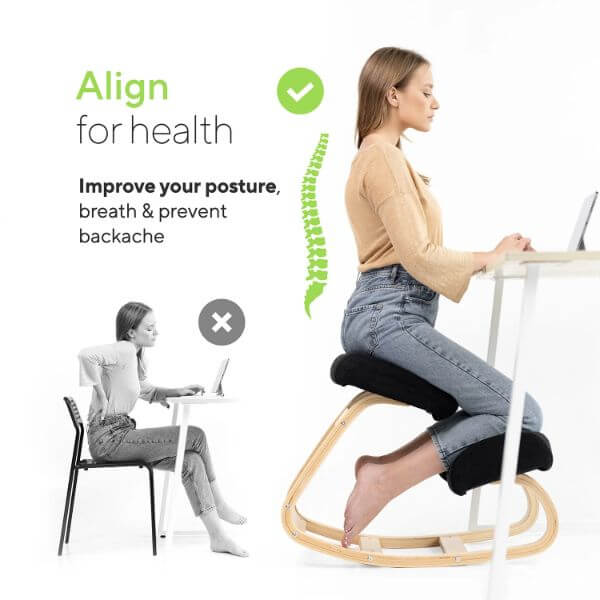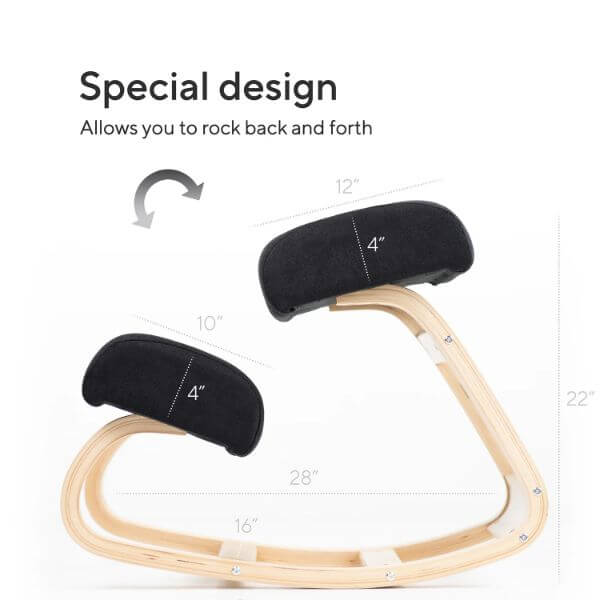In today’s fast-paced world, where many of us spend long hours working at our desks, comfort and ergonomics have become paramount. Enter the ergonomic kneeling desk chair, a revolutionary seating solution designed to alleviate discomfort, improve posture, and boost productivity.
In this article, we’ll dive deep into the world of ergonomic kneeling chairs, exploring what they are, how they work, the benefits they offer, and why they might be the game-changer your workspace needs.
Table of Contents
Our Top Recommendation
Our recommendation is Luxton Memory Foam Ergonomic Kneeling Chair. You can buy it here.






What Is an Ergonomic Kneeling Desk Chair?
First things first, what exactly is an ergonomic kneeling desk chair? Well, it’s not your typical office chair. Instead, it’s a uniquely designed seat that encourages you to maintain a more upright and balanced posture.
Unlike conventional chairs that have a backrest and a seat, ergonomic kneeling chairs feature a forward-sloping seat with a padded knee rest. This design encourages you to sit with your hips positioned forward, which can help reduce the strain on your lower back and promote better alignment of your spine.
How Does It Work?
The ergonomic kneeling chair works by shifting your body’s weight forward, which engages your core muscles and helps maintain the natural curve of your spine. Here’s how it works:
- Upright Posture: When you sit on an ergonomic kneeling chair, your hips are slightly forward, and your knees are supported by the padded cushion. This encourages a more upright posture, reducing the tendency to slouch or hunch over your desk.
- Engaged Core: To stay balanced on the chair, your core muscles are continuously engaged. This not only strengthens your core but also relieves pressure on your lower back.
- Reduced Lower Back Strain: By distributing your weight more evenly between your pelvis and knees, the chair can help reduce the strain on your lower back, making it a valuable tool for individuals who experience back pain.
The Benefits of Using an Ergonomic Kneeling Desk Chair
Now that you have a better understanding of how these chairs work, let’s explore the numerous benefits they offer:
- Improved Posture: One of the most significant advantages of using an ergonomic kneeling chair is improved posture. By encouraging an upright sitting position, it helps you maintain the natural curve of your spine, reducing the risk of slouching or slumping.
- Reduced Lower Back Pain: Many people experience lower back pain due to prolonged sitting in conventional chairs. Kneeling chairs distribute your weight differently, alleviating the pressure on your lumbar spine and potentially reducing lower back discomfort.
- Enhanced Core Strength: Sitting on a kneeling chair engages your core muscles as they work to keep you balanced. Over time, this can lead to increased core strength and stability.
- Better Blood Circulation: The open hip angle in kneeling chairs can promote better blood circulation in your legs and lower body. This can help prevent numbness or discomfort during extended periods of sitting.
- Increased Focus and Productivity: With improved comfort and reduced discomfort, you’re likely to stay more focused on your work, leading to increased productivity.
- Customizable Comfort: Most ergonomic kneeling chairs allow for height adjustments, ensuring that you can tailor the chair to your body’s unique needs.
- Compact and Space-Saving: Kneeling chairs are generally more compact and lightweight than traditional office chairs, making them ideal for smaller workspaces.
- Versatile Use: These chairs are not limited to office settings. They can be used for various tasks, including reading, studying, or even playing musical instruments.
Important Considerations Before Buying
While ergonomic kneeling chairs offer numerous benefits, they may not be suitable for everyone or for all tasks. Here are some important factors to consider before purchasing one:
- Adaptation Period: It can take some time for your body to adjust to sitting on an ergonomic kneeling chair. Expect an adaptation period during which you may experience some discomfort as your muscles get used to the new seating position.
- Workstation Compatibility: Ensure that your desk or workspace is compatible with a kneeling chair. You may need to adjust the height of your desk or use a height-adjustable desk to accommodate the chair comfortably.
- Health Conditions: If you have pre-existing health conditions or mobility issues, consult with a healthcare professional before using a kneeling chair. It may not be suitable for individuals with certain conditions.
- Task-Specific Use: While kneeling chairs are great for many tasks, they may not be the best choice for activities that require constant movement or reaching across a wide workspace.
- Ergonomic Accessories: Consider using ergonomic accessories such as a footrest or an ergonomic keyboard and mouse to further enhance your workspace comfort.
Tips for Using an Ergonomic Kneeling Desk Chair
To make the most of your ergonomic kneeling chair and ensure a comfortable experience, follow these tips:
- Gradual Adjustment: Start by using the chair for short periods and gradually increase the duration as your body adapts to the new sitting position.
- Proper Height: Adjust the chair’s height so that your feet are flat on the floor or supported by a footrest. Your knees should rest comfortably on the cushioned knee pad.
- Use Cushions: Consider adding cushions or padding to the knee rest and seat for added comfort during extended use.
- Breaks and Movement: Remember to take regular breaks to stand, stretch, and move around. Even with an ergonomic chair, sitting for prolonged periods is not ideal for your health.
- Monitor Position: Ensure that your computer monitor is at eye level to prevent straining your neck. You may need to adjust your monitor height when using a kneeling chair.
- Foot Placement: Keep your feet flat on the floor or on a footrest to maintain balance and reduce pressure on your knees.
- Stretching: Incorporate stretching exercises into your daily routine to prevent muscle stiffness and maintain flexibility.
- Regular Check-ins: Pay attention to your body’s feedback. If you experience discomfort or pain, make necessary adjustments or consult with a healthcare professional.
Conclusion
The ergonomic kneeling desk chair is a unique seating solution that has the potential to transform your workspace comfort and posture. With benefits ranging from improved posture to reduced lower back pain and enhanced productivity, it’s no wonder that these chairs have gained popularity.
However, it’s essential to consider your individual needs, workspace compatibility, and any pre-existing health conditions before making the switch to a kneeling chair. When used correctly and with proper adjustments, an ergonomic kneeling chair can become a valuable addition to your work or study routine, contributing to your overall well-being and comfort.

